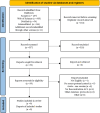A comparative analysis of the effects of proprioception and virtual reality exercises on postural balance in athletes with anterior cruciate ligament reconstruction: a systematic review and meta-analysis
- PMID: 40462014
- PMCID: PMC12131431
- DOI: 10.1186/s12891-025-08823-5
A comparative analysis of the effects of proprioception and virtual reality exercises on postural balance in athletes with anterior cruciate ligament reconstruction: a systematic review and meta-analysis
Abstract
Background: One factor that contributes to balance impairment after ACL reconstruction is balance. Balance impairment leads to decreased performance in athletes, limitations in daily activities, and increases the risk of re-injury. Despite the importance of addressing this issue, previous studies do not appear to have directly compared virtual reality (VR) training with proprioception training. This systematic review compares the effects of proprioception exercise and VR on postural balance in individuals with anterior cruciate ligament reconstruction (ACL-R).
Methods: A search was conducted in four databases: PubMed, Science Direct, Web of Science (WOS), and Scopus to find available sources from the beginning to the end of February 2025. Studies that assessed postural balance were selected. Quality assessment, risk of bias, and Quality assessment of the body of evidence of the studies were performed using the PEDro scale, A revised tool to assess risk of bias (RoB 2), and GRADE, respectively, by two authors, and any discrepancies were reported by a third person and consensus was reached by three people. Meta-analysis was performed using the Comprehensive Meta-Analysis V.3.0 software.
Results: Nine studies, with a total of 333 participants, Including 279 men and 54 women, were included in the present study. The meta-analysis conducted on the proprioception exercises section, which were evaluated dynamic balance in group 1 (Biodex Balance System), has Hedges` g an effect size (95% confidence intervals) of 0.697 (0.429 to 0.969), and in group 2 (Kinesthetic Ability Trainer) has 2.465 (-1.534 to 6.463) and static balance has 0.302 (0.037 to 0.568). VR exercise in dynamic balance has 0.390 (0.077 to 0.704). The quality of evidence for studies on VR exercises was high, proprioception exercises were low in static balance, and dynamic balance was moderate in Group 1 and very low in Group 2.
Conclusion: Research shows that both proprioception and VR exercises can help improve postural balance. Interestingly, when comparing the two under similar conditions, VR exercises may be more effective. The engaging nature of VR exercises can be a real advantage in helping people stick with the exercise and achieve better results. While these findings are promising, more high-quality research is needed. Future studies using rigorous methods will help us confirm these benefits and better understand how VR can be used to improve postural balance.
Clinical trial number: Not applicable.
Supplementary Information: The online version contains supplementary material available at 10.1186/s12891-025-08823-5.
Keywords: Anterior cruciate ligament reconstruction; Balance; Proprioception; Stability; Virtual reality.
Conflict of interest statement
Declarations. Ethics approval and consent to participate: Not applicable. Consent for publication: Not applicable. Competing interests: The authors declare no competing interests.
Figures









Similar articles
-
Virtual reality-based therapy after anterior cruciate ligament injury effectively reduces pain and improves knee function, movement patterns, and dynamic balance: A systematic review and meta-analysis.Knee Surg Sports Traumatol Arthrosc. 2025 May;33(5):1736-1753. doi: 10.1002/ksa.12477. Epub 2024 Sep 20. Knee Surg Sports Traumatol Arthrosc. 2025. PMID: 39302094 Free PMC article.
-
Neuromuscular training improves knee proprioception in athletes with a history of anterior cruciate ligament reconstruction: A randomized controlled trial.Clin Biomech (Bristol). 2020 Dec;80:105157. doi: 10.1016/j.clinbiomech.2020.105157. Epub 2020 Aug 27. Clin Biomech (Bristol). 2020. PMID: 32871397 Clinical Trial.
-
Biomechanical measures during landing and postural stability predict second anterior cruciate ligament injury after anterior cruciate ligament reconstruction and return to sport.Am J Sports Med. 2010 Oct;38(10):1968-78. doi: 10.1177/0363546510376053. Epub 2010 Aug 11. Am J Sports Med. 2010. PMID: 20702858 Free PMC article.
-
The Effects of Balance Training on Static and Dynamic Postural Stability Indices After Acute ACL Reconstruction.Glob J Health Sci. 2015 Jul 31;8(4):68-81. doi: 10.5539/gjhs.v8n4p68. Glob J Health Sci. 2015. PMID: 26573034 Free PMC article. Clinical Trial.
-
Effectiveness of virtual reality technology in rehabilitation after anterior cruciate ligament reconstruction: A systematic review and meta-analysis.PLoS One. 2025 Mar 3;20(3):e0314766. doi: 10.1371/journal.pone.0314766. eCollection 2025. PLoS One. 2025. PMID: 40029868 Free PMC article.
References
Publication types
LinkOut - more resources
Full Text Sources

